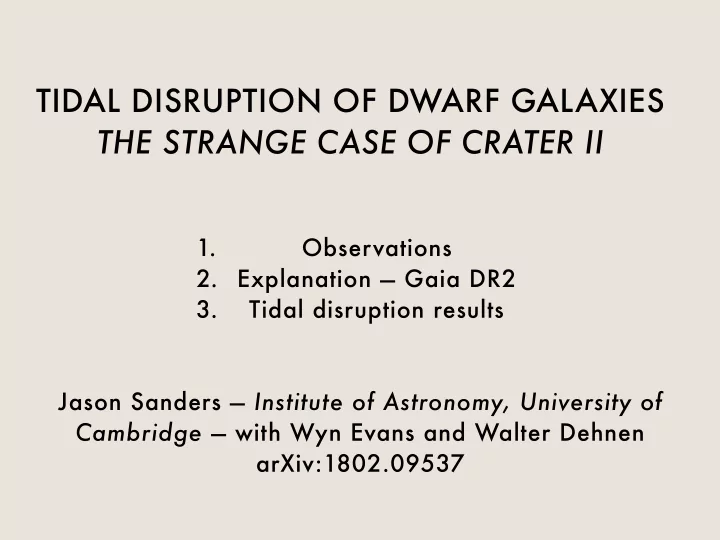

TIDAL DISRUPTION OF DWARF GALAXIES THE STRANGE CASE OF CRATER II 1. Observations 2. Explanation — Gaia DR2 3. Tidal disruption results Jason Sanders — Institute of Astronomy, University of Cambridge — with Wyn Evans and Walter Dehnen arXiv:1802.09537
WHY IS CRATER II STRANGE? Velocity dispersion Explanations 1. Formation 2. Projection effects 3. Tidal disruption 4. Alternative theories of gravity Half-light radius
EXPLANATION • Ran a suite of controlled two-component N-body simulations in a fixed Milky Way potential • Varied the flattening of C2, how embedded the stars are and the unknown proper motion. • Tidal disruption suppresses velocity dispersion (consistent with Penarrubia et al. 2007) — proper motion relative to solar reflex must be small to explain C2.
CONFIRMATION WITH GAIA DR2 FRITZ ET AL. 2018 Fritz Caldwell • Proper motion of C2 measured by Fritz et al. (2018) from Gaia DR2 • Agrees well with Caldwell et al. (2017) (from RVs) • Consistent with tidal disruption scenario
OTHER RESULTS Spherical model • Becomes prolate and tidally locked in outskirts Flattened model • Each pericentric passage shocks the dSphs to become more spherical. • Outskirts tend to prolate and tidally locked.
OTHER RESULTS • Models fall on sequence in shape. Disrupted models become steadily more prolate (within half the initial radius) • Flattened models become rounder then join the sequence • All heavily disrupted models appear round. • Cuspy models tend to overshoot C2 • More cored models balloon more at each pericentric passage so are more consistent with C2 — but don’t last as long.
Recommend
More recommend